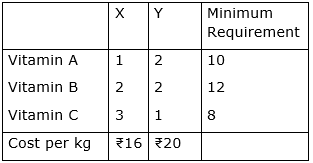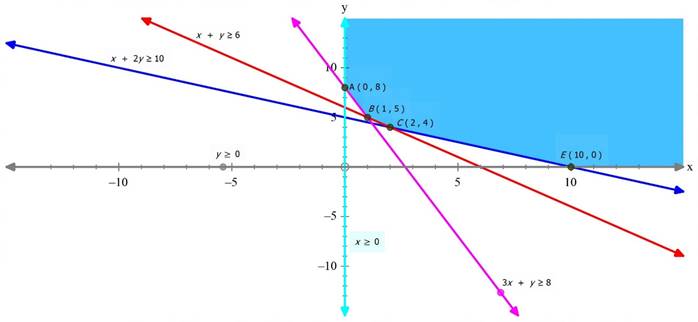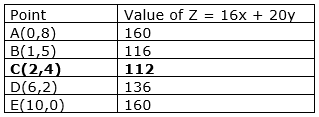A dietician wishes to mix together two kinds of food X and Y in such a way that the mixture contains at least 10 units of vitamin A, 12 units of vitamin B and 8 units of vitamin C. The vitamin contents of one kg food is given below :

One kg of food X costs ₹16 and one kg of food Y costs ₹ 20. Find the least cost of the mixture which will produce the required diet?
The above information can be expressed in the form of the following table:

Let the quantity of X and Y purchased be ‘x’ and ‘y’ kgs
Cost of X = 16x
Cost of Y = 20y
Cost of the mixture = 16x + 20y
Now,
⟹ x + 2y ≥ 10
i.e. the minimum requirement of Vitamin A from the mixture of X and Y is 10 units, each of which contains 1 unit and 2 units of Vitamin A respectively.
⟹ 2x + 2y ≥ 12
i.e. the minimum requirement of Vitamin B from the mixture of X and Y is 12 units, each of which contains 2units of vitamin B each.
⟹ 3x + y ≥ 8
i.e. the minimum requirement of vitamin C from the mixture of X and Y is 8 units, each of which contains 3 units and 1 unit of vitamin C respectively.
Hence, the mathematical formulation of the LPP is as follows :
Find ‘x’ and ‘y’ that:
Minimises Z = 16x + 20y
Subject to the following constraints:
(i) x + 2y ≥ 10
(ii) 2x + 2y ≥ 12
i.e. x + y ≥ 6
(iii) 3x + y ≥ 8
(iv) x,y ≥0 (∵ quantity cant be negative)

The feasible region is unbounded
The corner points of the feasible region is as follows:

Z is smallest at C(2,4)
Let us consider 16x + 20y ≤ 112
As it has no intersection with the feasible region, the smallest value is the minimum value.
The minimum cost of the mixture is ₹112.